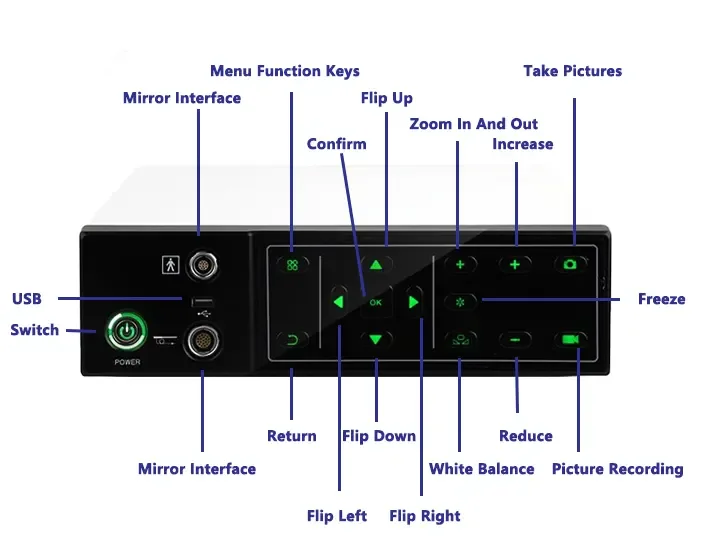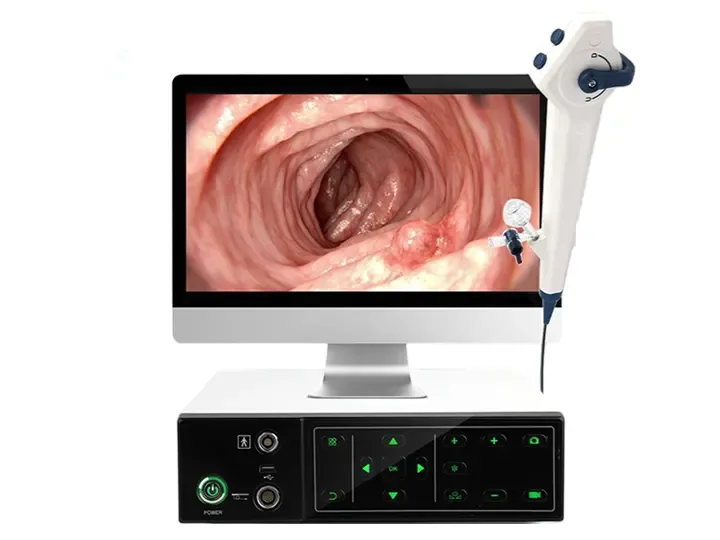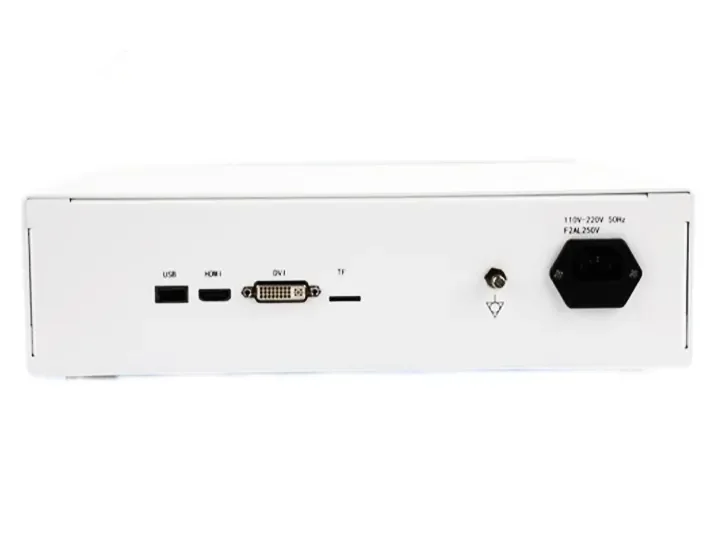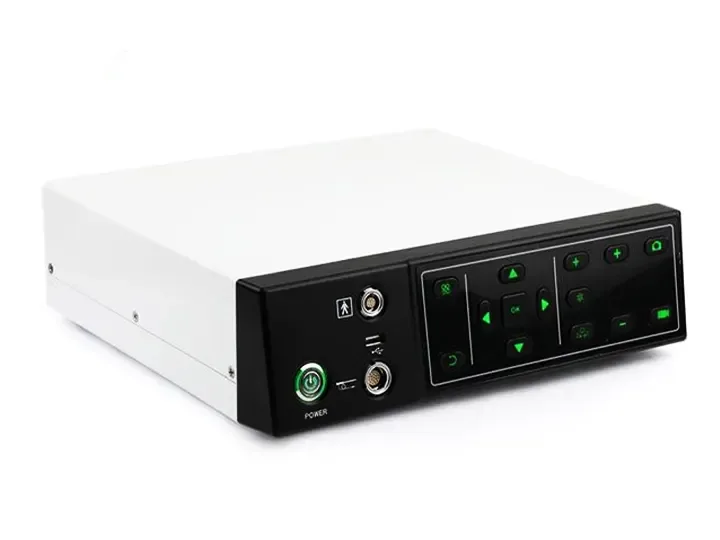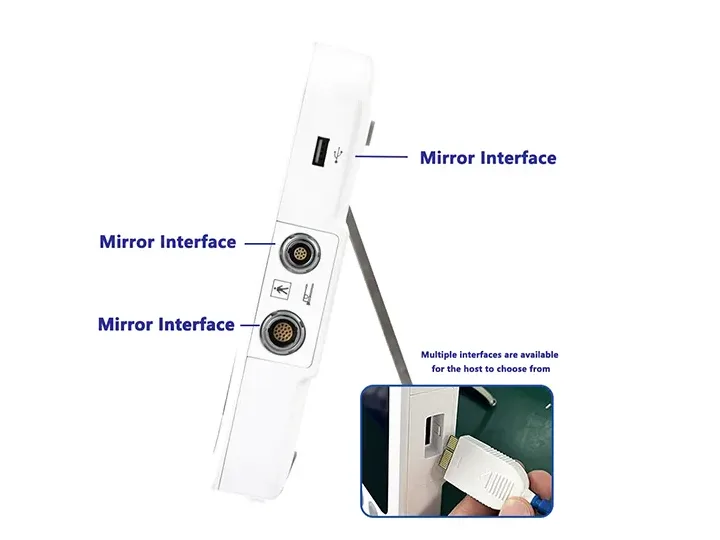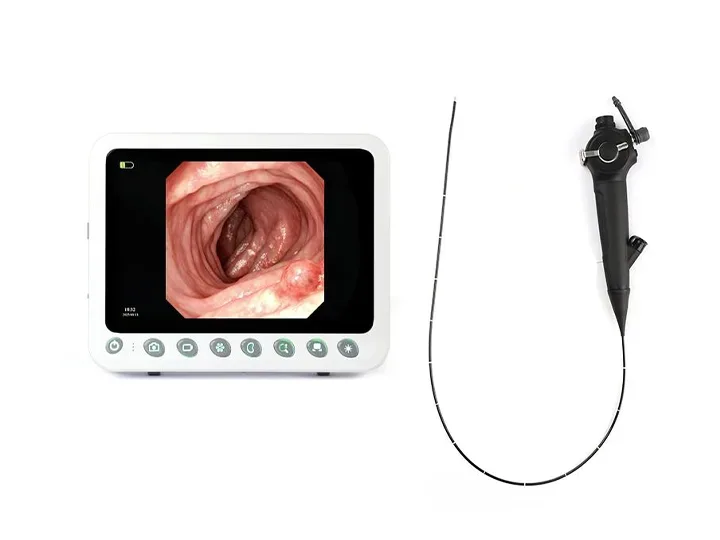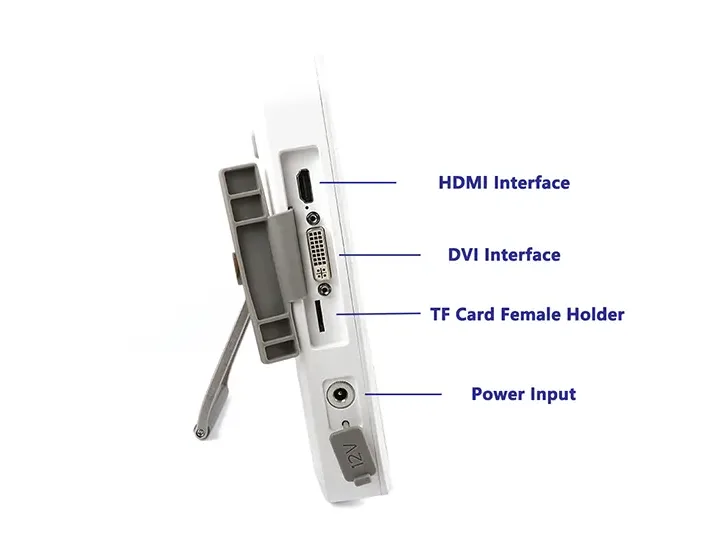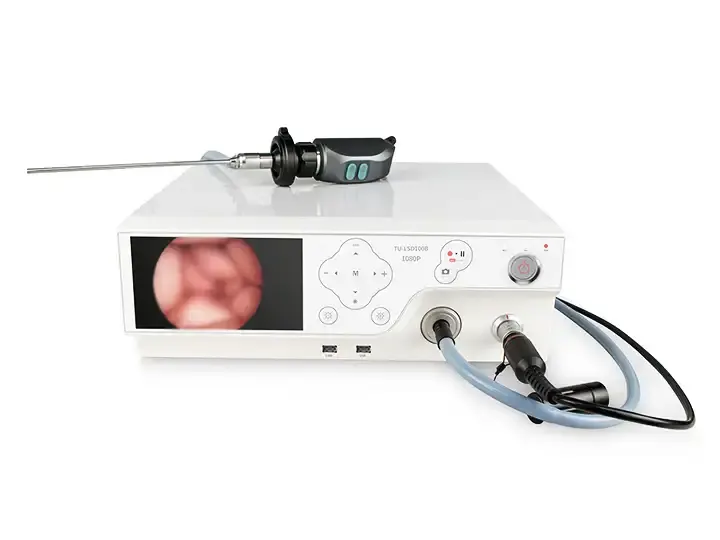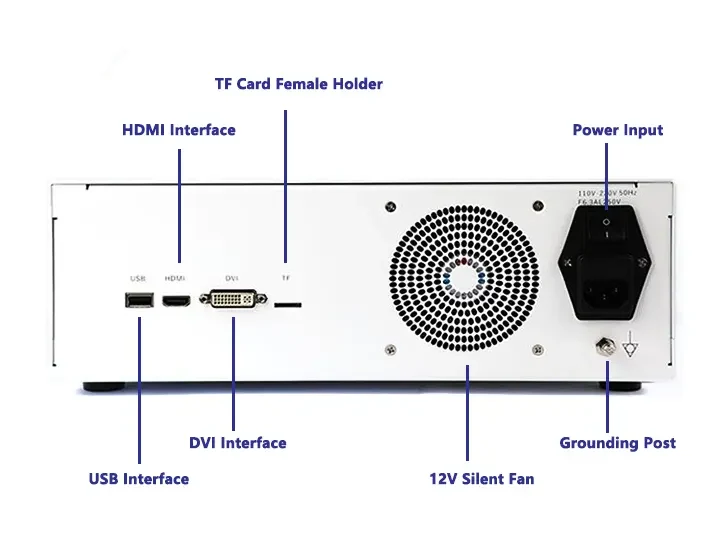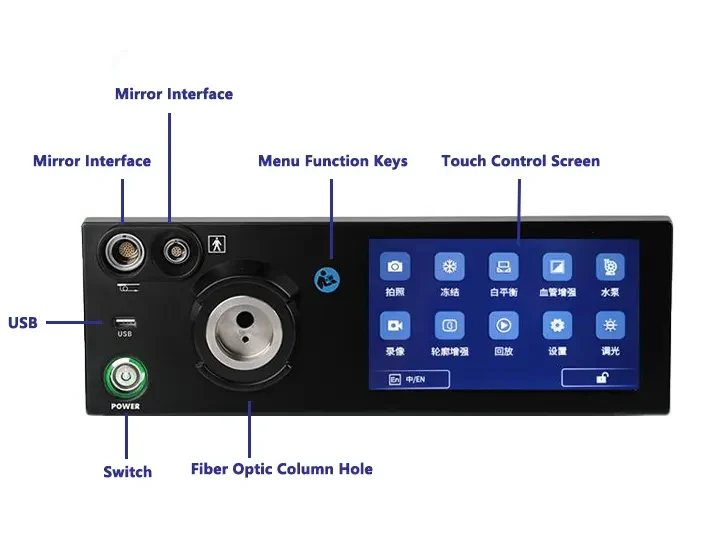Multifunctional Medical Endoscope Desktop Host
This desktop system delivers HD imaging (1920×1200) for ENT endoscopy medical endoscopes, enhancing diagnostic visualization. Optimizes clinical efficiency in endoscope medical procedures through dual control interfaces.
Technical Specifications
10.1-inch anti-bacterial touchscreen
Physical control knobs for sterile operation
HD imaging resolution (1920×1200)
HDMI/USB 3.0 video outputs
Desktop form with integrated carrying handle
Clinical Applications
Nasal endoscopy: Real-time mucosal examination
Laryngeal diagnostics: Vocal cord visualization
ENT clinic workflows: Rapid setup for procedures
Operational Features
Corrosion-resistant shell for disinfection compliance
Ergonomic design for practitioner use
Stable performance for ENT endoscopy medical endoscopes
Focused exclusively on core ENT endoscopic functions with tactile and touchscreen control.
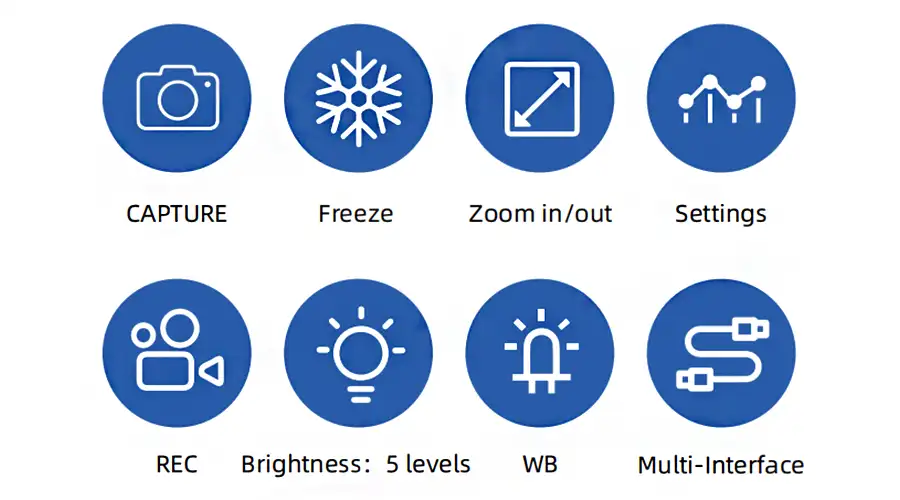
Strong Compatibility
Compatible with Gastrointestinal Endoscopes, Urological Endoscopes, Bronchoscopes, Hysteroscopes,Arthroscopes, Cystoscopes, Laryngoscopes, Choledochoscopes, Strong Compatibility.
Capture
Freeze
Zoom In/Out
Image Settings
REC
Brightness: 5 levels
WB
Multi-Interface
1920*1200 Pixel Resolution Image Clarity
with Detailed Vascular Visualization for Real-Time Diagnosis

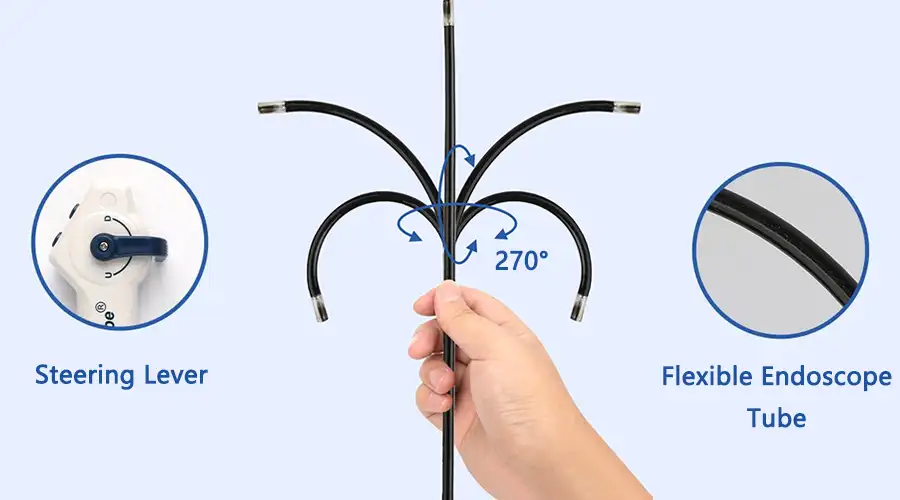
360-Degree Blind Spot-Free Rotation
Flexible 360-degree lateral rotation
Eliminates visual blind spots effectively
Dual LED Lighting
5 adjustable brightness levels, Brightest at Level 5
gradually dimming to OFF
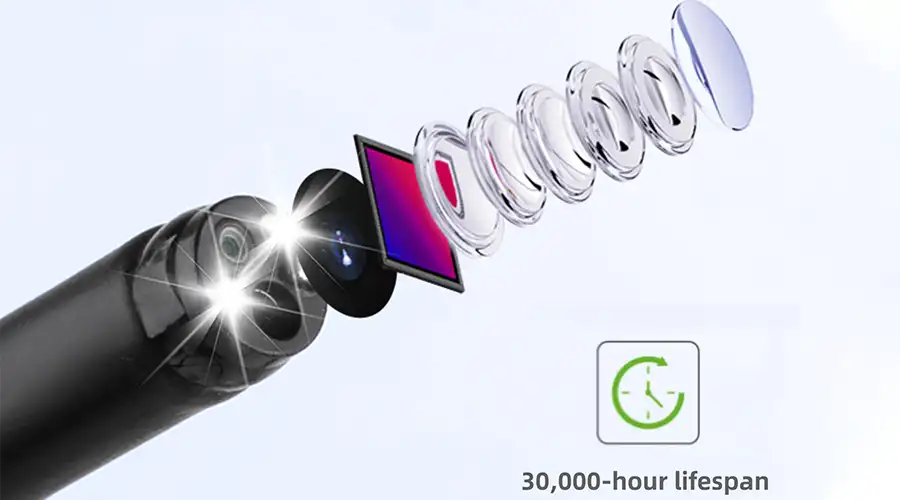
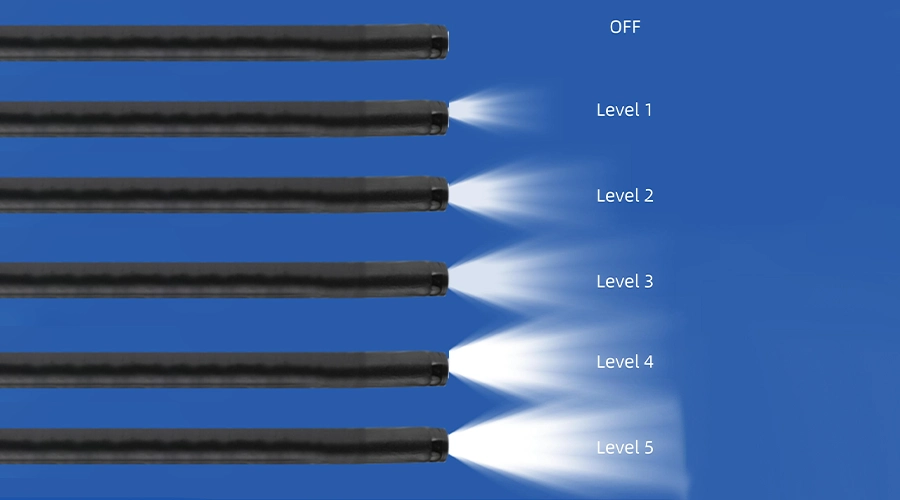
Brightest at Level 5
Brightness: 5 levels
OFF
Level 1
Level 2
Level 6
Level 4
Level 5
Manual 5x Image Magnification
Enhances detail detection
for exceptional results

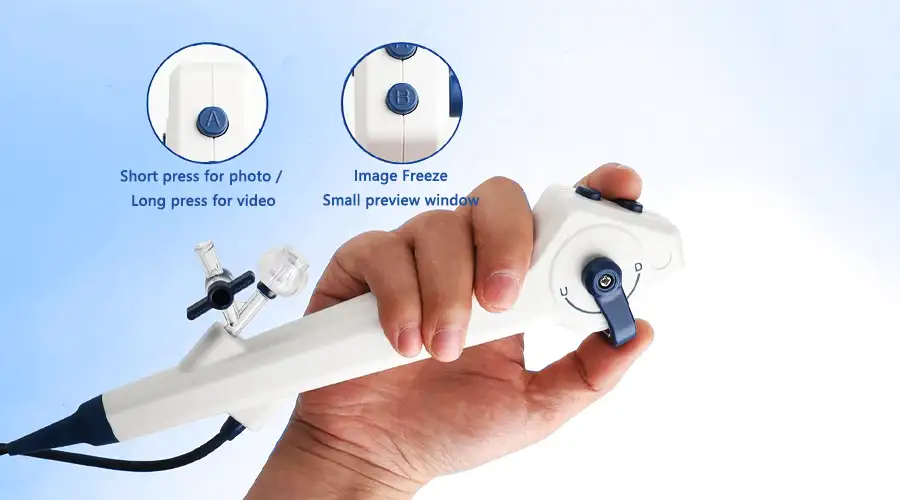
Photo/Video Operation One-touch control
Capture via host unit buttons or
handpiece shutter control
IP67-Rated High-definition waterproof lens
Sealed with special materials
for water, oil, and corrosion resistance

The multifunctional endoscope desktop host is an integrated, high-precision medical device mainly used for minimally invasive surgery, diagnostic examinations and treatment operations. The following is a comprehensive introduction from multiple dimensions:
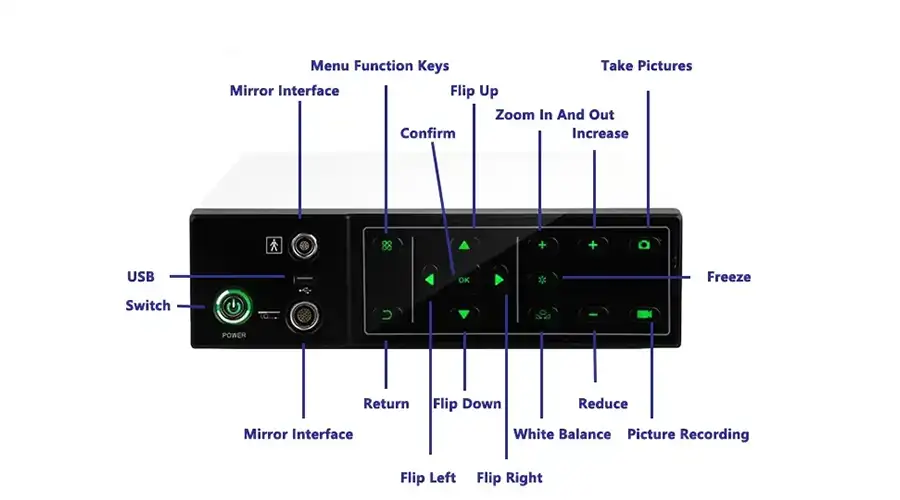
1. Core functions
High-definition imaging
Equipped with 4K/8K ultra-high-definition cameras, optical zoom lenses and intelligent image processing chips, it supports real-time image acquisition, magnification and detail enhancement, and can present high-contrast, low-noise tissue images.
Multispectral imaging
Some high-end models support fluorescence imaging (such as ICG fluorescence navigation), narrow-band light imaging (NBI) or infrared imaging to help identify tumor boundaries, vascular distribution, etc.
Intelligent assistance
Integrated AI algorithms can automatically mark lesion areas (such as early canceration), measure lesion size, and provide surgical path planning suggestions.
2. System composition
Host unit
Includes image processor, light source system (LED or xenon lamp), pneumoperitoneum machine (for laparoscopy), flushing pump (such as urology) and other modules, some of which support modular expansion.
Display and interaction
Equipped with a medical display of 27 inches or more, supporting touch or voice command input, and some models are compatible with 3D/VR display.
Endoscope compatibility
Can be connected to hard endoscopes (such as laparoscopes, arthroscopy) and soft endoscopes (such as gastroenteroscopes, bronchoscopes) to meet the needs of different departments.
3. Clinical application scenarios
Surgery
General surgery/hepatobiliary surgery: cholecystectomy, liver tumor resection
Urology: prostate electroresection, kidney stone lithotripsy
Gynecology: uterine fibroid removal, hysteroscopy
Diagnosis field
Gastroenterology: early cancer screening (ESD/EMR), polypectomy
Respiratory department: bronchial biopsy, alveolar lavage
Emergency and ICU
Used in emergency scenarios such as airway management and trauma exploration.
4. Technical advantages
Integrated design
Integrate light source, camera, pneumoperitoneum, electrosurgery (such as electrocoagulation/electroresection) and other functions to reduce intraoperative device switching.
Low-latency transmission
Adopt optical fiber or 5G wireless transmission, with a delay of less than 0.1 seconds, ensuring real-time operation.
Infection control
Supports high-temperature and high-pressure sterilization or disposable sterile sheath design, in line with infection prevention and control standards (such as FDA/CE certification).
5. High-end model features
Dual-scope joint system
Allows simultaneous access to two endoscopes (such as laparoscope + ultrasound endoscope) to achieve multimodal imaging.
Remote collaboration
Supports 5G remote consultation, and the surgeon can share images and annotate guidance in real time.
Force feedback robotic arm
Equipped with a robot-assisted system to improve operation accuracy (such as Da Vinci system compatible models).
6. Mainstream brands and models in the market
Olympus: EVIS X1 series (gastroenteroscopy), VISERA 4K UHD
Stryker: 1688 4K imaging system (orthopedics/laparoscopy)
Karl Storz: IMAGE1 S 4K (fluorescence navigation)
Domestic alternatives: Mindray Medical, Kaili Medical HD-550 and other models.
7. Procurement and maintenance considerations
Cost
Imported host is about 1-3 million yuan, domestic models are about 500,000-1.5 million yuan, and consumables (such as light source life) and maintenance costs need to be evaluated.
Training support
Suppliers are required to provide operation training (such as the use of AI tools) and simulation training modules.
Upgrade capability
Whether it supports online software updates or hardware expansion (such as future compatibility with 5G modules).
8. Development trend
Deep integration of AI
Development from auxiliary diagnosis to automated surgical planning (such as automatic avoidance of blood vessels and nerves).
Miniaturization and portability
Introducing a small desktop host to adapt to grassroots hospitals or field medical scenarios.
Multidisciplinary integration
Combining ultrasound, radiofrequency ablation and other technologies to achieve a one-stop "diagnosis-treatment" operation.
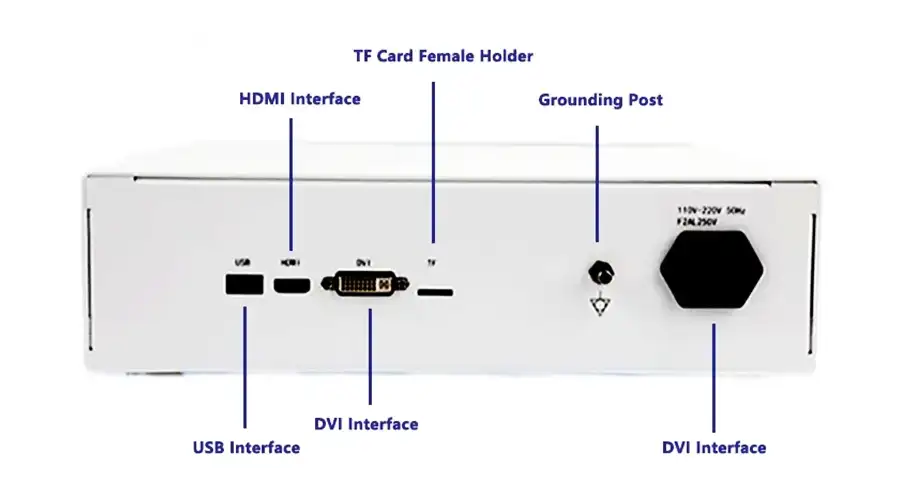
Summary
The multifunctional endoscope desktop host is developing in the direction of intelligence, precision and multidisciplinary collaboration. Its technological innovation has significantly improved the safety and efficiency of minimally invasive surgery, especially in early diagnosis of tumors and complex operations. When choosing, it is necessary to combine the department's needs, technical scalability and cost-effectiveness for comprehensive evaluation.
Faq
-
What are the advantages of multifunctional medical endoscope desktop host compared to traditional host?
Multi departmental compatibility: supports various endoscope bodies such as gastroscopy, colonoscopy, bronchoscopy, cystoscopy, hysteroscopy, etc., reducing the cost of repeated equipment procurement. Advanced imaging technology: equipped with 4K/8K ultra high definition, NBI (narrowband imaging), FICE (electronic staining) and other modes to improve lesion detection rate. Intelligent assistance functions: AI real-time analysis (such as polyp recognition, vascular enhancement), automatic exposure adjustment, image freezing, and measurement tools. Modular design: expandable modules for freezing, electrocautery, flushing, etc., to meet complex surgical needs.
-
How to operate the AI assisted diagnostic function of the multifunctional endoscope host?
Enable AI mode: Select the "AI Assist" option on the host interface (such as Olympus' CADe/CADx system). Real time tagging: AI will automatically select suspicious lesions (such as early gastric cancer, polyps) and prompt the risk level. Manual review: Doctors can adjust the observation angle based on AI suggestions, and if necessary, perform biopsy or video recording for archiving. Data management: AI analysis results can be synchronized to the hospital information system (HIS/PACS) for subsequent follow-up.
-
How to maintain the main unit and mirror body in daily use?
Host maintenance: Clean the ventilation opening after shutting down daily to prevent dust from blocking heat dissipation; Check the oxidation status of the fiber optic interface every month and wipe it with anhydrous alcohol; Regularly calibrate white balance and light source brightness. Mirror maintenance: Immediately soak in enzyme wash solution after surgery to avoid biofilm formation; Avoid bending or hitting the mirror body, and use a dedicated bracket for storage; Quarterly inspection, testing for air tightness and light guiding performance.
-
What could be the possible reason for frequent image lag or delay on the host?
Possible reasons and solutions: Insufficient transmission bandwidth: Replace with a higher specification video cable (such as HDMI 2.1 or fiber optic interface). System overload: Close unused software in the background (such as video playback), or upgrade the host memory/graphics card. Mirror compatibility issue: Confirm that the mirror matches the host model and update the driver firmware. Heat dissipation fault: Check if the host fan is running normally and clean the dust from the heat dissipation holes.
Latest articles
-
How XBX Cystoscope Supplier Ensures Quality and Precision for Hospital Procurement
Discover how the XBX Cystoscope Supplier provides hospitals with high-precision, OEM-ready endoscopy systems built for reliability, safety, and consistent imagi...
-
How XBX Bronchoscope Factory Delivers Reliable OEM Systems
Discover how the XBX Bronchoscope Factory ensures quality and reliability through advanced OEM manufacturing, optical precision, and strict quality control.
-
How XBX Laparoscope Minimizes Surgical Trauma in Abdominal Surgery
Discover how the XBX Laparoscope reduces surgical trauma through precision imaging, minimal incisions, and faster recovery in modern abdominal procedures.
-
How XBX Hysteroscope Detects and Removes Uterine Polyps
Discover how the XBX Hysteroscope enables precise detection and removal of uterine polyps, improving accuracy, safety, and comfort in women’s health care.
-
What Is an XBX Flexible Ureteroscope for Stone Removal?
Learn how the XBX flexible ureteroscope improves access, visibility, and efficiency in ureteral stone management with 4K imaging and ergonomic control.
Recommended products
-
Portable Hysteroscope Machine
The Portable Hysteroscope Machine (Portable Tablet Endoscope Host) delivers HD imaging and portability for hysteroscopy ...
-
4K Medical Endoscope Host
4K Medical Endoscope Host delivers ultra-HD imaging for medical endoscopes, enhancing diagnostic pre
-
Gastrointestinal medical endoscope desktop host
Gastrointestinal medical endoscope desktop host provides 4K imaging for procedures, enhancing diagno
-
Gastrointestinal Endoscope Host
Gastrointestinal Endoscope Host provides 4K medical imaging for medical endoscopes, enhancing diagno

